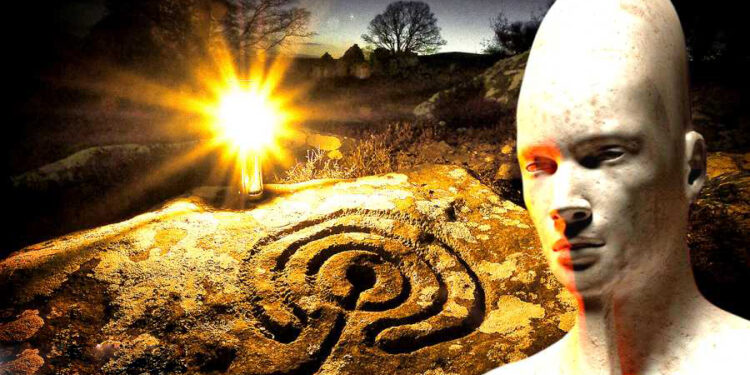A widely accepted hypothesis in alternative history is that a typical humanoid race existed before and after the Great Flood that shaped the civilization on Earth. Such beings are mentioned in the Old Testament in Bible as “fallen angels” and in the Sumerian literature, they are called the “Anunnaki.” Looking back in the past, a group of reputable scientists published a study that investigated an intelligent and industrial civilization that may have existed on planet Earth millions of years ago.
It would take only 10,000 years for the human presence to disappear from the planet which is so short in comparison to the age of Earth. If such a civilization existed, the traces would not be so evident – taking into account that more than 4 billion years of the Earth comprise a wide enough range for the evolution (and destruction) of intelligent life.
A peer-reviewed scientific paper published in the International Journal of Astrobiology was titled “The Silurian hypothesis: would it be possible to detect an industrial civilization in the geological record?” The name of the paper is a “Doctor Who” reference to the reptile-humanoids known as the Silurians, who in the cult science fiction show were once part of an advanced civilization on Earth during the Silurian period (some 400 million years ago).
The research grew out of a visit by physicist Adam Frank to NASA’s Goddard Institute to speak with scientist Gavin Schmidt. Frank was interested in studying whether any industrial civilization that arises on another planet will, through their own activity, trigger their own version of a climate shift.
But Schmidt asked another question: “How do you know we’re the only time there’s been a civilization on our own planet?”
The idea seems incredible to a scientist, but it is not so, at least not as something that does not deserve to be investigated and that can be ruled out from the outset. Instead of discussing aliens, the scientists got into a discussion about possible remnants of an ancient civilization.
The geologic record does not go back past what is called the Quaternary period 2.6 million years ago. For example, the oldest large-scale stretch of ancient surface lies in the Negev Desert. It is 1.8 million years old, and older surfaces are mostly visible in cross-section via something like a cliff face or rock cuts. Go back much farther than the Quaternary and everything was turned over and crushed to dust.
It is worth noting at this stage that the fraction of life that gets fossilized is extremely small and “varies widely as a function of time, habitat and degree of soft tissue versus hard shells or bones…for all the dinosaurs that ever lived, there are only a few thousand near-complete specimen, or equivalently only a handful of individual animals across thousands of taxa per 100,000 years.”
It is likely, for example, that if Homo sapiens disappeared today, in a few million years there would be no fossil records of our species. Our industrial civilization has only lasted for 300 years, and it may not last much longer. So, it is not implausible that a civilizational explosion could have existed during a similar time span in the past, and 500 years or so, compared to a window of billions of years, is nothing.
Tech items and fossils are unreliable. However, Franck and Schmidt noted that there is something by which the passage of hundreds of millions of years could be plumbed, “physicochemical tracers for previous industrial civilizations,” that is, anomalous changes in the chemicals found in the geological record that point at something odd happening.
For example, if we consider our own era, the Anthropocene, we have rare earth elements being used in computers, massive amounts of fertilizer being used for agriculture, the radiation resulting from nuclear reactors and bomb tests, plastics flooding the ocean, and a massive increase in atmospheric carbon. All of these things might be visible to scientists when they look at the chemistry of past eras.
And there are certain “mysteries” in the geological record that could be candidates for the “Silurian hypothesis.” For example, during the Eocene (56-34 million years ago), there was a number of “hyperthermal events” characterized by “significant negative carbon isotope excursions, warming and relatively high sedimentation rates driven by increases in terrigenous input,” and Arctic conditions showing “evidence of warming, lower salinity and greater anoxia,” that have been collectively named ELMOs: “Eocene Layers of Mysterious Origin.”
Of course, scientists must analyze the cases in order to determine if these anomalies were caused by natural events, which is obviously the most likely hypothesis. The work, on the other hand, could serve to apply models to other planets on which civilizations could have existed in remote times, such as the case of Mars, which at some point in its existence had a lot of water.
In 2014, NASA published a book entitled “Archaeology, Anthropology, and Interstellar” which considers extraterrestrial interference in human history. It notes the possibility that some rock art depictions on Earth may be of alien origin. It was edited by Douglas Vakoch, Director of the Search for ExtraTerrestrial Intelligence (SETI).
Douglas Vakoch, for his part, refers to the difficulties that may arise as a result of the first contact with an extraterrestrial civilization.
“If a radio signal is detected in a modern SETI experiment, we could well know that another intelligence exists, but not know what they are saying. Any rapid, information-rich fluctuations encoded in the radio signals might be smoothed out while collecting weak signals over extended periods of time, increasing the chances of detecting these signals, but losing the content they bear in the process.
Even if we detect a civilization circling one of our nearest stellar neighbors, its signals will have traversed trillions of miles, reaching Earth after traveling for years.”
“To move beyond the mere detection of such intelligence, and to have any realistic chance of comprehending it, we can gain much from the lessons learned by researchers facing similar challenges on Earth. Like archaeologists who reconstruct temporally distant civilizations from fragmentary evidence, SETI researchers will be expected to reconstruct distant civilizations separated from us by vast expanses of space as well as time. And like anthropologists, who attempt to understand other cultures despite differences in language and social customs, as we attempt to decode and interpret extraterrestrial messages, we will be required to comprehend the mindset of a species that is radically Other.”
On page 272, Vakoch writes about the desirability of establishing symbolic/linguistic communication with ETI. It is helpful to review some parallels from human existence that pose problems for us today. One of these is “rock art,” which consists of patterns or shapes cut into rock thousands of years ago.
Such ancient stone carvings can be found in many countries, and the example (as shown above) is from Doddington Moor, Northumbria, England. We can say little, if anything, about what these patterns signify, why they were cut into rocks, or who created them. For all intents and purposes, they might have been made by aliens. Unless we find a readable exegesis of them produced at the time they were made, we will never be able to say with certainty what the patterns mean.
Source: https://www.howandwhys.com/nasa-considers-extraterrestrial-contact-civilization-existed-millions-of-years-ago/

























